
The apiary is the place where wasps turn out to be one of the most harmful insects. And if their presence in a summer cottage or garden can still be forgiven (after all, these winged predators exterminate a large number of plant pests per day), then in the apiary, destroying bees, they cause only damage, and significant. That is why the fight against wasps in the apiary often becomes very relevant.

About how exactly you can save bees from wasps, we'll talk further ...
How dangerous were wasps for the apiary?
In order to effectively protect bees from wasps, the beekeeper needs, as they say, "to know the enemy by sight." So, for example, several varieties of wasps represent the greatest danger to bees:
- Hornets - absolutely everything, without exception. Moreover, if domestic species of these large wasps attack bees at a distance remote from their hives, then huge tropical hornets fly to the apiary in whole detachments and are able to destroy a multi-thousand family of honey bees in just a few hours. A group of 40-50 giant hornets destroys an average bee family of 30-40 thousand individuals in about 3 hours.

- Philanthus, also called the bee wolf, is a medium-sized solitary wasp that stores bees in minks for the subsequent feeding of its larvae. It takes 5-6 bees to develop one larva.During the season, one female philanthus destroys several dozen bees in this way.

In addition, ordinary paper wasps are not averse to sometimes catching a bee, but this is much more difficult for them - they are not “professional” bee hunters, and they mainly hunt injured and weakened insects. However, if wasps visit the hive in search of honey, they can seriously damage and devastate the cells of a weakened family, which can ultimately lead to its death.

At the same time, with the right approach, it is almost always possible to save bees from wasps. And when implementing such protection ahead of time, even before the start of robber attacks in apiaries, you can completely avoid losses, and even for the whole summer you will never see a sad picture of how wasps kill bees.
(The video posted at the end of the article clearly shows how organized and methodical wasps can act against bees, attacking the hive).
We protect the apiary ahead of time: what needs to be done in the spring?
Even in the spring, when the life of the bee colony is just entering its active phase, measures must be taken to protect the hive from wasp attacks: these protective measures must be comprehensive and thought out in advance to the smallest detail.
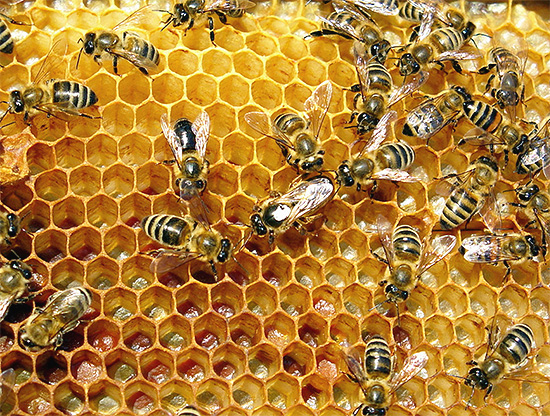
First, you should choose the right place to place the apiary. Ideally, the terrain for this should be with dense chernozem soils, a dense grassy cover, the absence of ravines, embankments and wastelands with sandy or clay bald spots (it is in such areas that the female philanthropists make holes and carry the captured bees here).
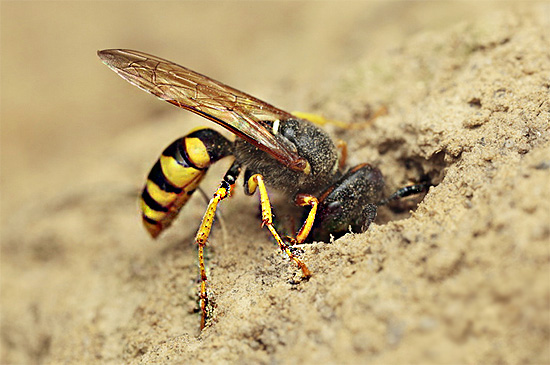
If there are still small sandy areas near the apiary, it is useful to plow them even in the cold season in order to reduce the number of philanthropists emerging from minks to the surface of the earth in spring.Sometimes this helps to save a huge number of bees, because in the spring the "bee wolves" simply will not hatch.
Secondly, it is useful to hang traps for wasps and hornets made from simple plastic bottles on an already placed apiary along the perimeter of the territory. It is not difficult to make such traps, and at the same time they protect the bees very well.
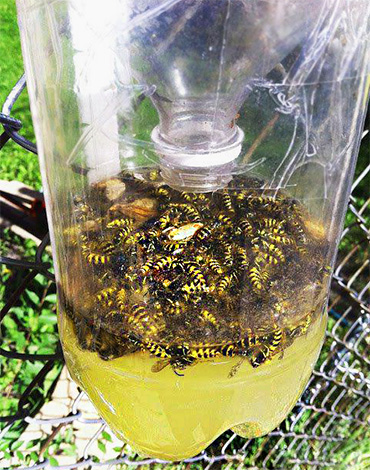
To make a trap, you need an ordinary plastic bottle: the upper third is cut off from it, the bait is poured onto the bottom of the bottle, and the separated top is turned upside down and inserted inside the bottom of the bottle. The wasps, attracted by the bait, climb into the trap through the neck, but are no longer able to get out.
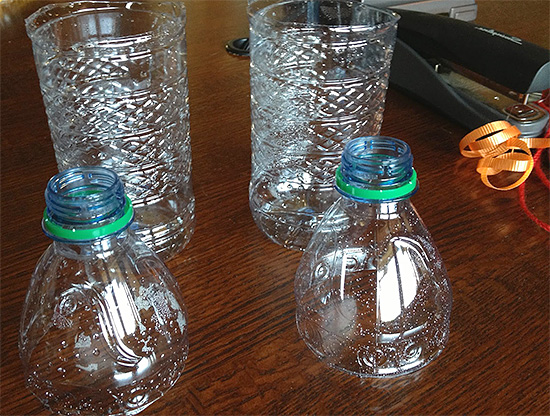
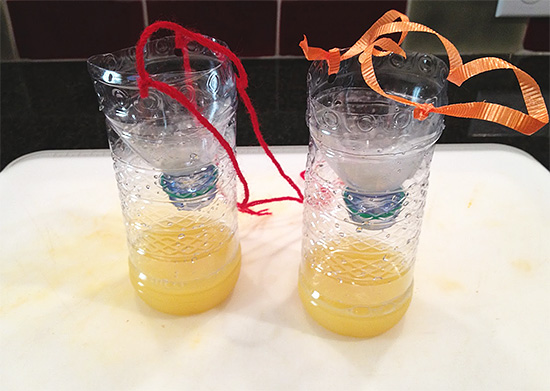
As baits in traps, you can use jam (preferably fermented or sour), beer, kvass, mash. The more such traps are placed in the apiary, the more bees can be saved.
In addition, already in the spring it is useful to pay attention to the emerging wasps and trace their movements: sometimes you can even find a wasp nest in a dense bush and destroy it in a timely manner.
If the wasps are already robbing: methods for their destruction
If the wasps found the apiary, and the beekeeper noticed their attacks on the bees, then it is urgent to take additional measures to combat the attacking predators.
Additionally, you can protect bees in different ways:
- More carefully search for wasp nests near the apiary.

- Use special glue traps to protect the hive from wasps (placed, for example, on the lid of the hive). A sweet fermented bait is placed in the center of such glue traps.Wasps will first of all flock to this “dessert”, and then they simply won’t be able to start hunting for bees, as they will stick firmly. For example, thanks to such traps, it is possible to catch most of the hornets even before they begin to rob.

Important!
When choosing bait, you need to remember that bees can flock to sweet foods. That is why - to minimize the number of attracted bees - baits must be fermented.
- Manually catch and destroy philanthropists (usually there are not so many of them in the territory). Many beekeepers, having seen a flying philant, will certainly try to destroy it - for example, they hit it with a special firecracker made of fine mesh. Regular and targeted catching of philanthus allows you to reliably protect bees from these wasps.

It is interesting
Philanthropist bites are relatively painless and usually do not cause severe inflammation. Experienced, "worldly-wise" beekeepers often simply catch these wasps with their bare hands - in an adult man, they are not able to pierce the rough skin on the palms with a sting.
In addition, as noted above, traps made from bottles help well in beekeeping to combat wasps. If in the spring they are hung more for prevention, then with the mass appearance of wasps in the apiary, the number of traps must be increased - the more there are, the more reliably it will be possible to protect the apiary.
Sometimes up to a hundred wasps and more can fall into a two-liter bottle a day.
How to find and destroy a hornet's nest?
Finding a wasp nest in a forest or in rugged steppe terrain is a rather difficult task.Well, if it is located right next to the apiary, and the beekeeper has the opportunity to find it without additional funds. More often, the nest of wasps is located at a great distance, sometimes in inaccessible hollows or burrows in the ground, and it can be very difficult to find it without additional tricks.

An effective method for finding wasp nests is to mark the insects. To do this, the insect is caught with a net, a light and long red ribbon is neatly tied at its “waist”, after which the wasp is released. Usually within half an hour or an hour she returns to her nest, and thanks to a noticeable tape, she will be easy to follow. In this way, it can be easy to identify even hard-to-see wasp nests in tall trees.
Wasp dwellings are destroyed in various ways. Firstly, the nest can be burned by dousing it with gasoline or kerosene. However, if you decide to deal with wasps in this way, then you must strictly follow the relevant fire safety rules. Always keep in mind that not only the nest itself can catch fire, but also objects located next to it - for example, a tree branch or the roof of an outbuilding.
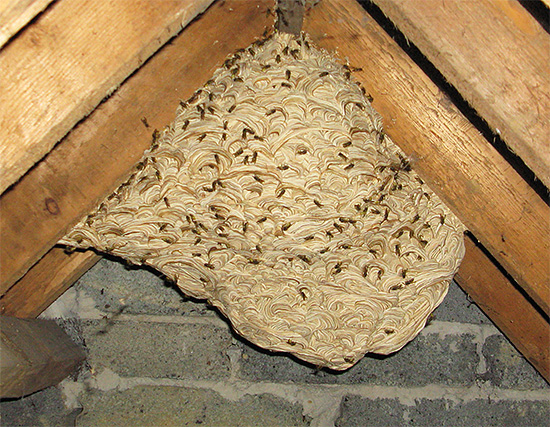
Secondly, the nest can be filled with water - for example, in the case when it is located in an earthen hole (note that sometimes this may require several buckets of water). After the hole is flooded, the entrance to it must be closed with a stone of a suitable size so that the wasps cannot get out.
Thirdly, the nest can be wrapped in a bag into which a powerful insecticide is pre-poured.If the nest is located in a hollow, then the insecticidal agent is simply poured into it, and the entrance to the hollow is clogged with a gag made of cloth soaked with the same preparation.
As a poisonous drug, you can choose both somewhat outdated drugs - Aktar, Chlorophos, Karbofos, Chlorpyrifos, as well as more modern, less dangerous for humans, but very effective against wasps - Delta Zone, Get, Lambda Zone, Xulat Micro, etc.

It is advisable to destroy the nest at night, dressed so that the whole body is covered with thick clothes, and use a beekeeper's mask to protect the head.
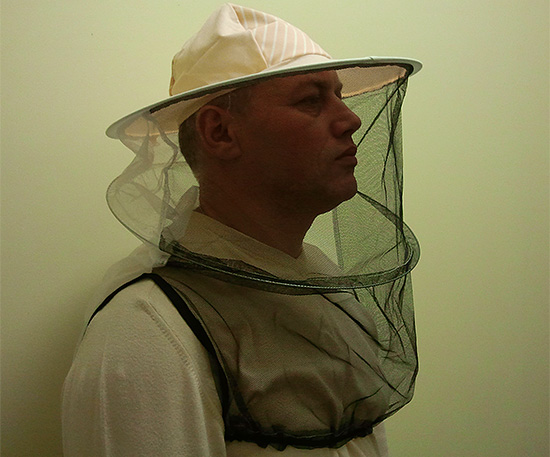
Despite the variety of options for dealing with wasps, perhaps the most reliable way to protect bees from them is to take care of the hives and prevent the appearance of weak colonies. A strong bee family is quite capable of standing up for itself: wasps against bees protecting the hive with the whole family simply cannot do anything. Even hornets - and those are able to penetrate the hive only in exceptional cases.
On a note
Under natural conditions, hornets are not able to destroy a family of bees. In most of the territory of our country, there are hornets of relatively small size, capable of catching only single bees. And in places where huge hornets live, local bees have a unique mechanism of protection against them, called by scientists a “thermal ball” (bees en masse surround the hornet, creating a deadly temperature for it in the center of such a ball). Apiary tragedies happen when European bees, more efficient at collecting honey but lacking such protection, are transported to Japan. There - if huge wasps attacked the hive - with a high probability the honey family will be completely destroyed.
The video below shows how wasps attack bees - even a multi-thousand bee colony has almost no chance to withstand such an attack ...
Interesting video: a group of several hornets attacks a bee hive
And then the video shows the protection of bees from wasps. And here, just a huge hornet, the most dangerous for bees, approached the hive. The organized protection of a strong family left him no chance.
The bees destroyed the hornet, united together ...

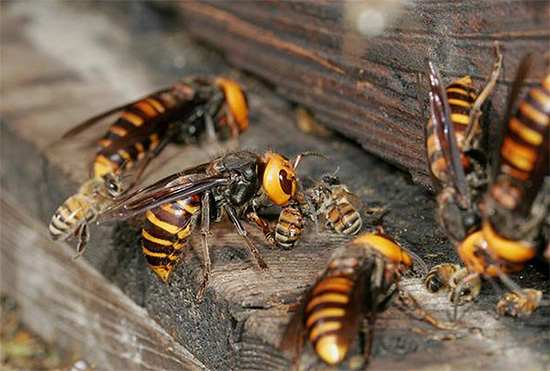
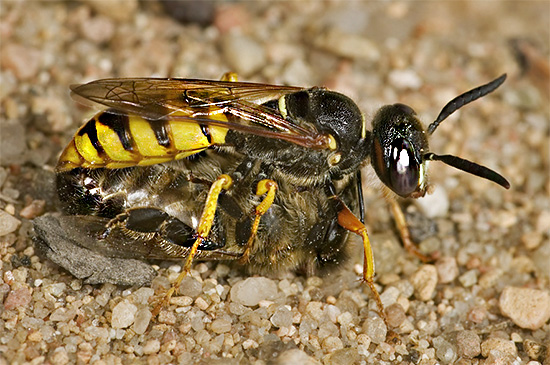


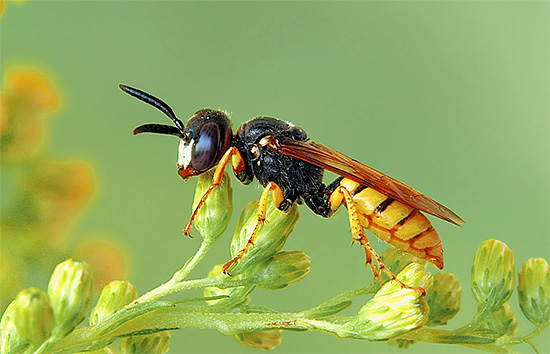

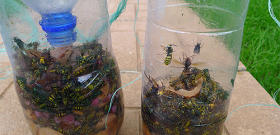
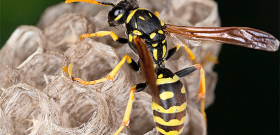
Thank you for the article!